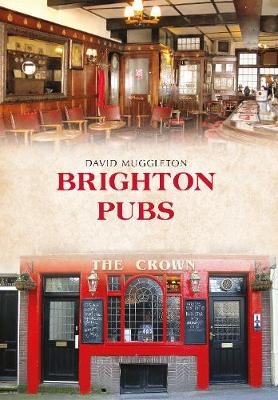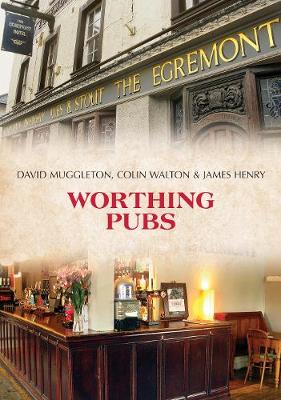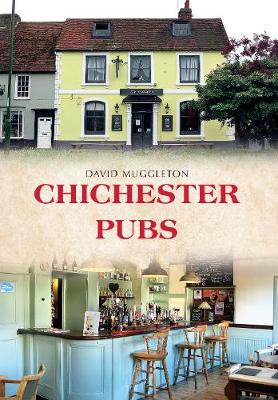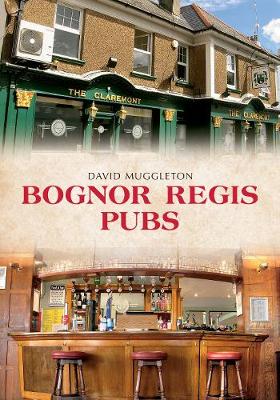Pubs
5 total works
Brighton has long been an important seaside town, and today draws in visitors from all over Britain and beyond for its varied nightlife, rich history and attractive waterfront. In 1800, Brighton had forty-one inns and taverns, and by 1860 there were well over 450, echoing the town’s growth in popularity through the Regency and early Victorian eras. A recent resurgence of interest in real ale has also seen a welcome boom in micro-breweries, placing Brighton firmly on the beer-lover’s map.
David Muggleton takes us on a tour of these watering holes, including the long-established venerable Greyhound, elegant Regency Cricketers, high-Victorian Colonnade, elaborate mock-Tudor King & Queen and the English Renaissance revivalist Good Companions, the pub reputed to have opened on the very day that the Second World War began. Brimming with quirky tales and fascinating facts, this carefully crafted guide initiates readers into the fascinating history of Brighton’s pubs.
David Muggleton takes us on a tour of these watering holes, including the long-established venerable Greyhound, elegant Regency Cricketers, high-Victorian Colonnade, elaborate mock-Tudor King & Queen and the English Renaissance revivalist Good Companions, the pub reputed to have opened on the very day that the Second World War began. Brimming with quirky tales and fascinating facts, this carefully crafted guide initiates readers into the fascinating history of Brighton’s pubs.
The hamlet of Worthing began to develop as a fashionable seaside resort during the late eighteenth century. It attained town status in 1803 when its administration was invested in a board of commissioners that first met at the Nelson Hotel. Inns of greater antiquity were the White Horse at West Tarring, the Maltsters Arms at Broadwater and the Anchor in Worthing High Street. Other well-established pubs, such as the town centre Warwick and the Cricketers at Broadwater, began as basic beer retailers and brewing victuallers of the early Victorian period.
Several pubs in the area are of architectural interest. The ornate Grand Victorian opened in 1900 as the Central Hotel, the half-timbered design of the Thomas á Becket (1910) was in homage to the nearby medieval Parsonage Row cottages, while the imposing Downlands was built in 1939 in the classic roadhouse style. Worthing Pubs takes us on a fully illustrated tour of the historical hostelries in the district, yet also acknowledges how the local drinking culture has been shaped by the contemporary craft-beer bar and the burgeoning micropub scene.
Several pubs in the area are of architectural interest. The ornate Grand Victorian opened in 1900 as the Central Hotel, the half-timbered design of the Thomas á Becket (1910) was in homage to the nearby medieval Parsonage Row cottages, while the imposing Downlands was built in 1939 in the classic roadhouse style. Worthing Pubs takes us on a fully illustrated tour of the historical hostelries in the district, yet also acknowledges how the local drinking culture has been shaped by the contemporary craft-beer bar and the burgeoning micropub scene.
As a principal market town, many of Chichester’s inns and taverns were established at an early date, including those offering hospitality for pilgrims travelling to the cathedral for worship at the thirteenth-century shine of St Richard. Of nearly all the medieval houses – such as the Tabard, the Star, and the Plough – nothing except names in old documents survives. The number of pub closures has escalated since the 1980s. Yet Chichester still has at least three pubs continuously trading since the eighteenth century, while several others now closed retain original architectural features worthy of note. The deregulation of the trade has also seen the emergence of contemporary café-bar-pubs, such as the Belle Isle. David Muggleton takes us on a tour of this compact but elegant city, taking in the classical Georgian Ship Hotel, where General Eisenhower stayed in the lead-up to D-Day; the mid-Victorian Four Chesnuts and the mystery of its missing ‘T’; the gabled and jettied mock-Tudor Nags Head of 1925; and the Duke & Rye, recently established in a Gothic Revival church building.
Once a small fishing hamlet, the origins of modern Bognor Regis lie in the attempt by Sir Richard Hotham to develop this part of the south coast as a fashionable resort in the late eighteenth century. Hotham’s original profession is given in the name of the town’s JD Wetherspoon outlet, the Hatter’s Inn, while the pub originally called the Railway Tavern has recently been renamed the Hothampton Arms in memory of Hotham’s preferred name for his resort. The oldest pub still trading in the town is the William Hardwicke, which was built by 1817 as the New Inn. Bognor expanded with the arrival of the railway in 1864, which led to the building of new pubs such as the Terminus and the development of those already existing such as the Alexander Tavern.
David Muggleton takes us on a walking tour of this seaside town’s finest pubs, taking in the ex-Berkeley Arms, now home to the town museum; the Claremont Inn, whose interwar interior makes it a CAMRA heritage pub of some regional importance; and the Punch & Judy, originally the Orlando, but recently renamed as a reminder of the Tony Hancock film The Punch & Judy Man, filmed partly on location in the town. Well researched and beautifully illustrated, Bognor Regis Pubs provides something for everyone, whether they have lived in this venerable old seaside resort all their lives or are visiting this part of the West Sussex coast for the first time.
David Muggleton takes us on a walking tour of this seaside town’s finest pubs, taking in the ex-Berkeley Arms, now home to the town museum; the Claremont Inn, whose interwar interior makes it a CAMRA heritage pub of some regional importance; and the Punch & Judy, originally the Orlando, but recently renamed as a reminder of the Tony Hancock film The Punch & Judy Man, filmed partly on location in the town. Well researched and beautifully illustrated, Bognor Regis Pubs provides something for everyone, whether they have lived in this venerable old seaside resort all their lives or are visiting this part of the West Sussex coast for the first time.
Horsham is the natural capital of the western end of Sussex’s forest ridge, its significance and development dating from the medieval period when it became an important market centre and home to the county assizes. Horsham also became a very significant brewing town, being the home of King & Barnes. Although the family firm, closed in 2000, the legacy continues to be reflected in the town’s drinking culture today and with the opening of a number of small breweries in the town and surrounding area in recent years.
In Horsham Pubs David Muggleton guides us through this high Wealden town to visit its fascinating and varied hostelries, many of which have retained features and traditions of previous ages. The originally expanded around The Carfax, in which stands the eighteenth-century Crown Inn. The Bishopric is another ancient street and home to the Kings Arms, known by 1667, and the probably even older Olive Branch, originally the Green Dragon and timber-framed with wattle and daub panels. Other pubs include the Brewhouse & Kitchen recently opened in the former Horse & Groom pub; the Malt Shovel, formerly the Michell Arms after one of the town’s former brewers and rebuilt in 1939; and the Anchor Tap, once appurtenant to the Anchor Hotel and reopened as a pub in 2016 – the local branch of the Campaign for Real Ale was founded here in 1975. Our tour also takes us out of the town centre to the Foresters Arms, a genuine community pub for a residential area; the Boars Head, a country farmhouse that became the Fox & Hounds until being renamed in 1971; and the new Chapeau Brewery taproom located on an industrial estate. This carefully crafted guide will initiate readers into the fascinating history of Horsham’s pubs.
In Horsham Pubs David Muggleton guides us through this high Wealden town to visit its fascinating and varied hostelries, many of which have retained features and traditions of previous ages. The originally expanded around The Carfax, in which stands the eighteenth-century Crown Inn. The Bishopric is another ancient street and home to the Kings Arms, known by 1667, and the probably even older Olive Branch, originally the Green Dragon and timber-framed with wattle and daub panels. Other pubs include the Brewhouse & Kitchen recently opened in the former Horse & Groom pub; the Malt Shovel, formerly the Michell Arms after one of the town’s former brewers and rebuilt in 1939; and the Anchor Tap, once appurtenant to the Anchor Hotel and reopened as a pub in 2016 – the local branch of the Campaign for Real Ale was founded here in 1975. Our tour also takes us out of the town centre to the Foresters Arms, a genuine community pub for a residential area; the Boars Head, a country farmhouse that became the Fox & Hounds until being renamed in 1971; and the new Chapeau Brewery taproom located on an industrial estate. This carefully crafted guide will initiate readers into the fascinating history of Horsham’s pubs.




